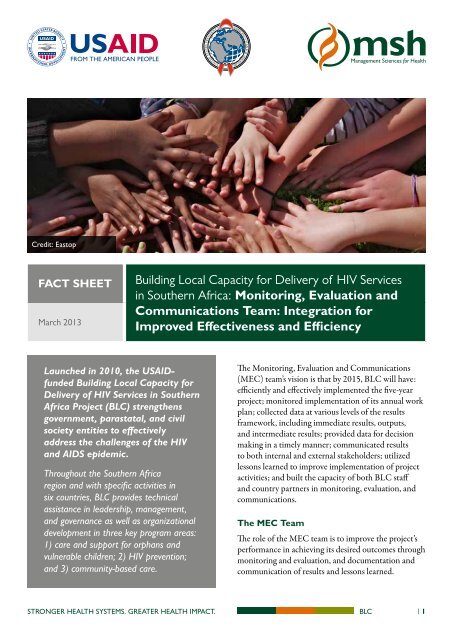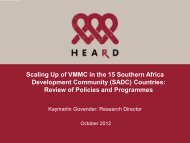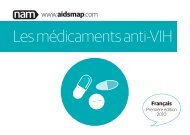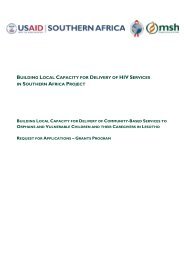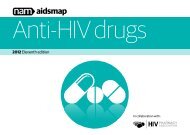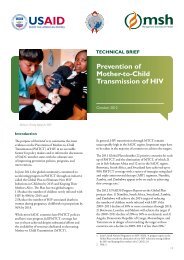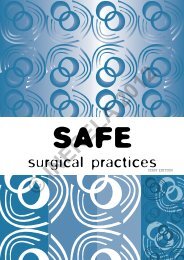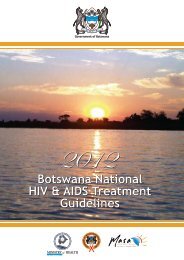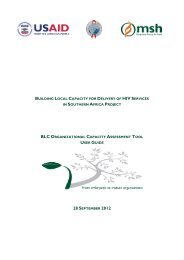View/Download file - Southern Africa HIV and AIDS Regional ...
View/Download file - Southern Africa HIV and AIDS Regional ...
View/Download file - Southern Africa HIV and AIDS Regional ...
Create successful ePaper yourself
Turn your PDF publications into a flip-book with our unique Google optimized e-Paper software.
Credit: Eastop<br />
FACT SHEET<br />
March 2013<br />
Building Local Capacity for Delivery of <strong>HIV</strong> Services<br />
in <strong>Southern</strong> <strong>Africa</strong>: Monitoring, Evaluation <strong>and</strong><br />
Communications Team: Integration for<br />
Improved Effectiveness <strong>and</strong> Efficiency<br />
Launched in 2010, the USAIDfunded<br />
Building Local Capacity for<br />
Delivery of <strong>HIV</strong> Services in <strong>Southern</strong><br />
<strong>Africa</strong> Project (BLC) strengthens<br />
government, parastatal, <strong>and</strong> civil<br />
society entities to effectively<br />
address the challenges of the <strong>HIV</strong><br />
<strong>and</strong> <strong>AIDS</strong> epidemic.<br />
Throughout the <strong>Southern</strong> <strong>Africa</strong><br />
region <strong>and</strong> with specific activities in<br />
six countries, BLC provides technical<br />
assistance in leadership, management,<br />
<strong>and</strong> governance as well as organizational<br />
development in three key program areas:<br />
1) care <strong>and</strong> support for orphans <strong>and</strong><br />
vulnerable children; 2) <strong>HIV</strong> prevention;<br />
<strong>and</strong> 3) community-based care.<br />
The Monitoring, Evaluation <strong>and</strong> Communications<br />
(MEC) team’s vision is that by 2015, BLC will have:<br />
efficiently <strong>and</strong> effectively implemented the five-year<br />
project; monitored implementation of its annual work<br />
plan; collected data at various levels of the results<br />
framework, including immediate results, outputs,<br />
<strong>and</strong> intermediate results; provided data for decision<br />
making in a timely manner; communicated results<br />
to both internal <strong>and</strong> external stakeholders; utilized<br />
lessons learned to improve implementation of project<br />
activities; <strong>and</strong> built the capacity of both BLC staff<br />
<strong>and</strong> country partners in monitoring, evaluation, <strong>and</strong><br />
communications.<br />
The MEC Team<br />
The role of the MEC team is to improve the project’s<br />
performance in achieving its desired outcomes through<br />
monitoring <strong>and</strong> evaluation, <strong>and</strong> documentation <strong>and</strong><br />
communication of results <strong>and</strong> lessons learned.<br />
STRONGER HEALTH SYSTEMS. GREATER HEALTH IMPACT. BLC<br />
| 1
The MEC team consists of six staff in the main<br />
office in South <strong>Africa</strong>, as follows: MEC Director;<br />
Senior M&E Advisor; two M&E Advisors; two<br />
Communication Advisors. There are also currently<br />
M&E staff in three of BLC’s six country programs:<br />
Angola, Lesotho, <strong>and</strong> Namibia. As a regional project,<br />
M&E <strong>and</strong> communications staff work as an entire<br />
team. The MEC team in the main office supports all of<br />
the country offices, but the country offices also support<br />
each other in addressing common <strong>and</strong> complex<br />
technical challenges.<br />
The MEC unit has a unique structure, with M&E <strong>and</strong><br />
communications staff organized as one team. This<br />
organization is more effective than the more common<br />
separately managed functions — it serves the goals of<br />
knowledge management, which is critical to effective<br />
public health programming. By combining MEC<br />
staff in a single unit, the team’s contributions to four<br />
key knowledge management processes are facilitated,<br />
namely: knowledge capture <strong>and</strong> organization;<br />
knowledge generation <strong>and</strong> synthesis; knowledge<br />
sharing <strong>and</strong> communication; <strong>and</strong> knowledge<br />
adaptation.<br />
Knowledge management is especially<br />
important in light of the BLC project’s<br />
regional scope <strong>and</strong> commitment to<br />
leveraging effective program approaches,<br />
best <strong>and</strong> promising practices, tools, <strong>and</strong><br />
lessons learned across the countries in which<br />
it works <strong>and</strong> within <strong>and</strong> beyond the regional<br />
<strong>and</strong> country projects it is implementing.<br />
M&E <strong>and</strong> communications functions <strong>and</strong> MEC staff<br />
are involved in each stage of the project cycle. For<br />
example, MEC staff collaborate with program staff<br />
in designing country projects, including helping to<br />
develop appropriate indicators, contributing lessons<br />
learned, <strong>and</strong> planning for communications products.<br />
The MEC team conducts quarterly data validation<br />
visits in order to maintain high quality st<strong>and</strong>ards<br />
<strong>and</strong> the reliability of data reported, thereby ensuring<br />
regular monitoring of project activities as well as<br />
reflection on progress <strong>and</strong> needs. During these data<br />
verification visits, MEC staff also collect information<br />
2<br />
Project design<br />
7<br />
Reformulaion<br />
of needs<br />
1<br />
Situational<br />
analysis & needs<br />
assessment<br />
3<br />
Implementation<br />
6,1<br />
Lessons learned<br />
The Project<br />
Management<br />
Cycle<br />
4<br />
Monitoring, review<br />
& reflection<br />
6<br />
Evaluation<br />
5<br />
Reporting<br />
STRONGER HEALTH SYSTEMS. GREATER HEALTH IMPACT. BLC<br />
| 2
<strong>and</strong> materials for the development of communications<br />
products, such as case studies, lessons learned writeups,<br />
<strong>and</strong> to prepare stories profiling beneficiaries <strong>and</strong><br />
the <strong>HIV</strong> services they have received.<br />
MEC Liaisons<br />
MEC staff are assigned as liaisons to BLC regional<br />
<strong>and</strong> country projects <strong>and</strong> to thematic areas (e.g.,<br />
Global Fund, orphans <strong>and</strong> vulnerable children, <strong>HIV</strong><br />
prevention, etc.). In this way, country projects <strong>and</strong><br />
technical areas benefit from continuous M&E <strong>and</strong><br />
communications support. The liaison assignments<br />
allow BLC country <strong>and</strong> technical staff to have M&E<br />
<strong>and</strong> communications “coaches”. When supporting<br />
programs, MEC staff simultaneously build BLC<br />
internal capacity in M&E <strong>and</strong> communications, which<br />
further integrates the M&E <strong>and</strong> communications<br />
functions. Thus, both the structure <strong>and</strong> organization of<br />
the MEC team benefit the entire BLC project in ways<br />
greater than if M&E <strong>and</strong> communications functions<br />
were not integrated. MEC staff benefit from this<br />
working relationship as they, in turn, learn about <strong>and</strong><br />
are “coached” in capacity building <strong>and</strong> other technical<br />
areas. This is another unique feature of the BLC’s team<br />
approach to project management <strong>and</strong> implementation.<br />
Tools <strong>and</strong> Products<br />
Several tools that st<strong>and</strong>ardize M&E <strong>and</strong><br />
communications processes for the BLC project have<br />
been developed by the MEC team. Many of these<br />
tools facilitate the preparation of key products that<br />
benefit all BLC staff, stakeholders, <strong>and</strong> the general<br />
public. For example, information collected <strong>and</strong><br />
provided for routine quarterly reporting to USAID<br />
is used to prepare or update factsheets on country<br />
programs, technical briefs, <strong>and</strong> case studies. Success<br />
stories profiling beneficiaries <strong>and</strong> key features of<br />
specific programs are shared with the larger MSH<br />
for its global e-newsletters <strong>and</strong> with USAID for its<br />
publications.<br />
Tools Developed<br />
Performance Monitoring Plan<br />
M&E Framework<br />
Communications Strategy<br />
Data collection <strong>and</strong> Reporting<br />
Templates<br />
Database<br />
Description<br />
Monitors <strong>and</strong> project progress against expected results <strong>and</strong><br />
timeframes. It describes all indicators, specifying data source,<br />
responsible person, collection methodology, <strong>and</strong> frequency of<br />
collection.<br />
A collection of st<strong>and</strong>ards, strategies, plans, information management<br />
<strong>and</strong> reporting systems, <strong>and</strong> accountable relationships for effective<br />
project M&E.<br />
Directs how the project positions itself <strong>and</strong> communicates results<br />
with various stakeholders.<br />
Developed to facilitate collection <strong>and</strong> presentation of project<br />
information <strong>and</strong> results. Examples are reports <strong>and</strong> story templates,<br />
registers, <strong>and</strong> forms.<br />
On <strong>and</strong> offline tool to record, track <strong>and</strong> analyze BLC information,<br />
including plans <strong>and</strong> results.<br />
The relationship between the team’s two key functions of M&E <strong>and</strong> communications is further illustrated in the<br />
graphic that follows. This diagram describes, in effect, a continuum, from the collection of simple data on inputs to<br />
the documentation of intermediate outcomes <strong>and</strong> impact, <strong>and</strong> the associated production of a range of increasingly<br />
sophisticated <strong>and</strong> complex communications materials.<br />
STRONGER HEALTH SYSTEMS. GREATER HEALTH IMPACT. BLC<br />
| 3
Relationship between the Results Framework <strong>and</strong> Communications Mechanisms/Products<br />
Results Framework Levels <strong>and</strong> Definition<br />
Communication Mechanisms / Products<br />
Impact<br />
Highest level of change<br />
reasonably attributed to the<br />
intervention – long-term<br />
sustainable effect from one or<br />
more IRs<br />
Journal Articles<br />
Abstracts<br />
Intermediate<br />
Outcomes /<br />
Results<br />
Change in behaviour or practice<br />
– are medium-term effects that<br />
logically occur from one or<br />
more immediate results<br />
Technical Briefs /<br />
White Papers<br />
Immediate<br />
Outcomes<br />
/ (Long <strong>and</strong><br />
short-term)<br />
Results<br />
Outputs<br />
Change in abilities, awareness<br />
<strong>and</strong> access – are short-term<br />
effects of outputs<br />
Direct products, goods<br />
or services resulting from<br />
completed activites<br />
Fact Sheets<br />
A Closer Look<br />
Success Story<br />
Lessons Learned<br />
Quarterly & Annual Reports<br />
Activities<br />
Action taken or work<br />
performed through which<br />
inputs are mobilized to produce<br />
outputs<br />
Case Study<br />
Friday Forwards<br />
Inputs<br />
Financial, human, material <strong>and</strong><br />
information resources<br />
Blogs<br />
This publication is made possible by the generous support<br />
of the United States Agency for International Development<br />
(USAID) under the Leader with Associates Cooperative<br />
Agreement GPO-A-00-05-00024-00. The contents are the<br />
responsibility of The Building Local Capacity for Delivery of<br />
<strong>HIV</strong> Services in <strong>Southern</strong> <strong>Africa</strong> Project <strong>and</strong> do not necessarily<br />
reflect the views of USAID or the United States Government.<br />
For more information contact:<br />
Building Local Capacity Project<br />
Ditsela Place<br />
1204 Park Street (Cnr Park <strong>and</strong> Jan Shoba Streets) Hatfield,<br />
Pretoria, South <strong>Africa</strong><br />
Tel: +27 12 364 0400; Fax: +27 12 364 0416<br />
blcsouthernafrica@msh.org; www.msh.org<br />
STRONGER HEALTH SYSTEMS. GREATER HEALTH IMPACT. BLC<br />
| 4


